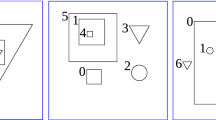Abstract
Ion Mobility Spectrometry (IMS) provides a means for analyzing the substances a person exhales. In this paper, we report on an approach to support early diagnosis of bronchial carcinoma based on such IMS measurements. Given the peaks in a set of ion mobility spectra, we first cluster these peaks with a modified k-means algorithm. We then apply probabilistic relational modelling and learning methods to a logical representation of the data obtained from the ion mobility spectra and the peak clusters. Markov Logic Networks and the MLN system Alchemy are employed for various modelling and learning scenarios. These scenarios are evaluated with respect to ease of use, classification accuracy, and knowledge representation aspects.





Similar content being viewed by others
Notes
Some of the determined probabilities differed extremely, depending on the inference algorithm used for calculation (i. e. some probabilities were almost 1.0 when calculated with one algorithm, but almost 0.0 when calculated with another one). Even when just adjusting some parameter of one algorithm, some probabilities changed drastically although they ought to change only approximately.
References
Baumbach J, Bunkowski A, Lange S, Oberwahrenbrock T, Kleinbölting N, Rahmen S, Baumbach JI (2007) IMS2—an integrated medical software system for early lung cancer detection using ion mobility spectometry data of human breath. J Integr Bioinform 4(3):75
Baumbach JI, Westhoff M (2006) Ion mobility spectometry to detect lung cancer and airway infections. Spectrosc Eur 18(6):22–27
Bödeker B, Vautz W, Baumbach JI (2008) Peak finding and referencing in MCC/IMS–data. Int J Ion Mobil Spectrom 11(1–4):83–87
Bödeker B, Vautz W, Baumbach JI (2008) Visualization of MCC/IMS–data. Int J Ion Mobil Spectrom 11(1–4):77–81
Dehaspe L, Toironen H (2000) Discovery of relational association rules. In: Relational data mining. Springer, pp 189–208
Finthammer M, Beierle C, Fisseler J, Kern-Isberner G, Möller B, Baumbach JI (2010) Probabilistic relational learning for medical diagnosis based on ion mobility spectrometry. In: Hüllermeier E, Kruse R, Hoffmann F (eds) Information processing and management of uncertainty in knowledge-based systems. Communications in computer and information science, vol 80. Springer, pp 365–375
Getoor L, Taskar B (eds) (2007) Introduction to statistical relational learning. MIT
Kersting K, De Raedt L (2007) Bayesian logic programming: theory and tool. In: An introduction to statistical relational learning. MIT
Kok S, Singla P, Richardson M, Domingos P, Sumner M, Poon H, Lowd D, Wang J (2008) The Alchemy system for statistical relational AI: user manual. Department of Computer Science and Engineering, University of Washington
MacQueen JB (1967) Some methods of classification and analysis of multivariate observations. In: Proceedings of the fifth berkeley symposium on mathematical statistics and probability, pp 281–297
Möller B (2009) Probabilistisches logikbasiertes Lernen und Modellieren für die Atemgasanalyse. Diploma thesis, Technische Universität Dortmund
Muggleton S, De Raedt L (1994) Inductive logic programming: theory and methods. J Log Program 19/20:629–679
Pearl J (1988) Probabilistic reasoning in intelligent systems. Morgan Kaufmann, San Mateo, Ca
Richardson M, Domingos P (2006) Markov logic networks. Mach Learn 62(1):107–136
Srinivasan A (2007) The Aleph manual. www.comlab.ox.ac.uk/activities/machinelearning/Aleph/
Author information
Authors and Affiliations
Corresponding author
Additional information
The research reported here was partially supported by the DFG (BE 1700/7-1 and KE 1413/2-1), by Germany’s high-tech strategy funds (Project Metabolit-01SF0716) and by the European Union (Project No. 217967). We thank Dr. M. Westhoff (Lung clinic Hemer), Dr. Th. Perl (University Göttingen), B. Möller, B. Bödeker, and B&S Analytik for their successful cooperation, valuable contributions, and general support.
Rights and permissions
About this article
Cite this article
Finthammer, M., Beierle, C., Fisseler, J. et al. Using probabilistic relational learning to support bronchial carcinoma diagnosis based on ion mobility spectrometry. Int. J. Ion Mobil. Spec. 13, 83–93 (2010). https://doi.org/10.1007/s12127-010-0042-9
Received:
Revised:
Accepted:
Published:
Issue Date:
DOI: https://doi.org/10.1007/s12127-010-0042-9




